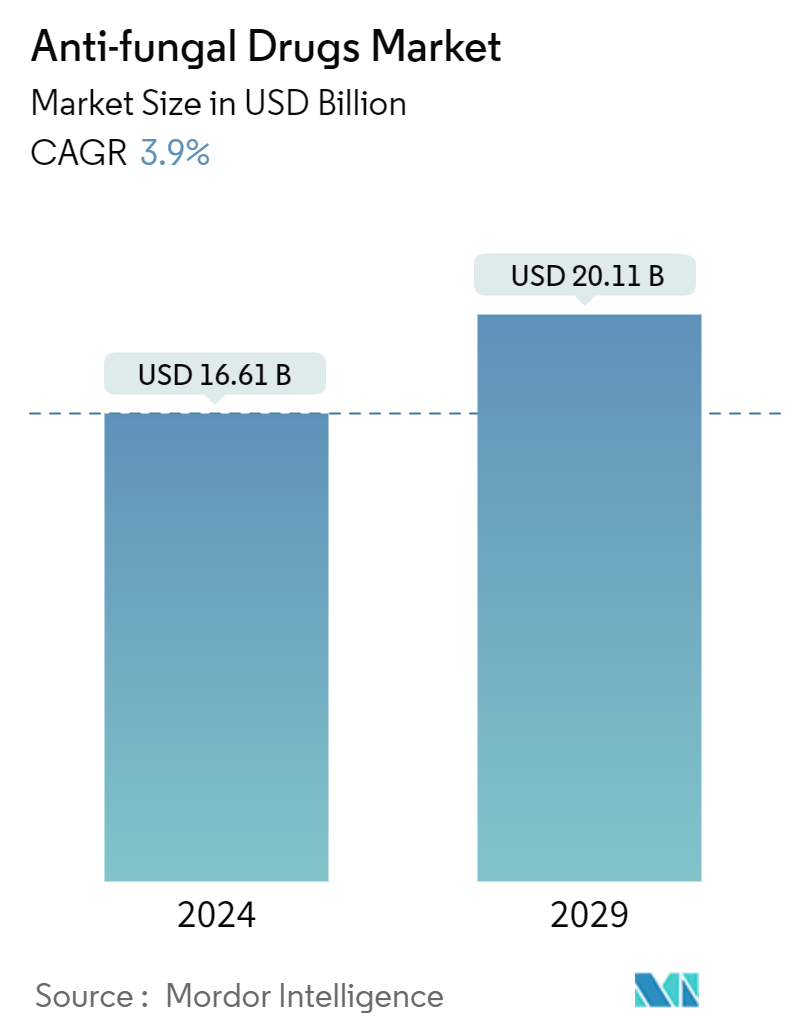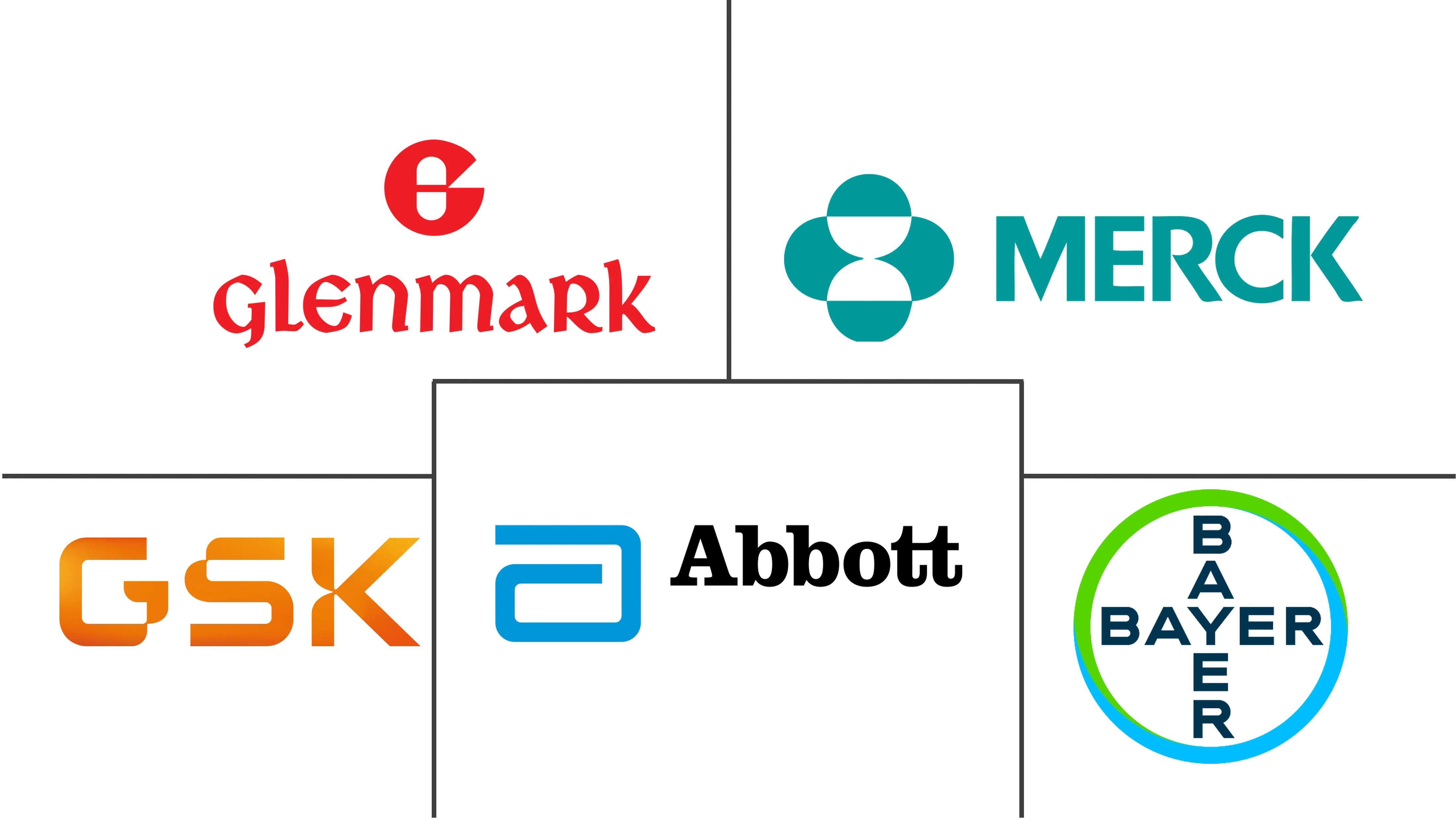Market Size of Antifungal Drugs Industry

| Study Period | 2019 - 2029 |
| Market Size (2024) | USD 16.61 Billion |
| Market Size (2029) | USD 20.11 Billion |
| CAGR (2024 - 2029) | 3.90 % |
| Fastest Growing Market | Asia Pacific |
| Largest Market | North America |
Major Players
*Disclaimer: Major Players sorted in no particular order |
Antifungal Drugs Market Analysis
The Anti-fungal Drugs Market size is estimated at USD 16.61 billion in 2024, and is expected to reach USD 20.11 billion by 2029, growing at a CAGR of 3.9% during the forecast period (2024-2029).
The major factors contributing to the growth of the anti-fungal drugs market include increased awareness of many fungal infections, rising numbers of over-the-counter (OTC) anti-fungal drugs, and increased use of antimicrobial drugs in developing countries. The growing popularity of OTC drugs such as clotrimazole, econazole, ketoconazole, miconazole, and amorolfine has resulted in many patients using OTC drugs.
An increase in onychomycosis cases, a fungal infection of the fingers and toes, is also expected to contribute to the market’s growth. For instance, according to the data updated by the CDC in September 2022, onychomycosis affected up to 14% of the general population in the world, and fungal toenail infections became more common than fungal fingernail infections.
Additionally, excessive glucose can lead to high cellular damage, resulting in several infectious and non-infectious skin disorders. Therefore, diabetes patients are more susceptible to various fungal infections, and onychomycosis is one of the major infections among the target population. For instance, according to an article published in the Journal of Fungi in August 2022, when a group of people was studied for skin and nail disorders in diabetic patients, onychomycoses were found common in critically ill diabetic patients.
Furthermore, the same study stated that dermatophytes were found to be the commonest cultural isolates (50%), followed by yeasts and molds in 30.8% and 19.2%, respectively, of the diabetes patients. Hence, the high burden of diseases among the target population is expected to increase the demand for antifungals and contribute to the overall growth of the market studied over the forecast period.
Moreover, the increasing focus of companies on adopting key strategic activities such as product launches, mergers and acquisitions, collaborations, and partnerships is further expected to boost the availability of anti-fungal drugs in the market over the forecast period. For instance, in June 2022, Apex Labs introduced the advanced Supra Bioavailable Itraconazole 65 and 130 mg capsules, a potent therapeutic option for effectively controlling fungal infections. Supra Bioavailable Itraconazole capsules deliver a higher percentage (90%) of active medicine to the biological system at a lesser dose. This advanced preparation also ensures lesser inter-individual variability, which may translate into enhanced efficacy in the management of fungal infections, according to a statement from the company.
Thus, the growing incidence of fungal infection and strategic activities adopted by market players is expected to contribute to market growth over the forecast period. However, increasing resistance to anti-fungal drugs and the side effects of these drugs are anticipated to hinder their adoption and demand, thereby restraining the market's growth.
Antifungal Drugs Industry Segmentation
As per the scope of this report, anti-fungal drugs are used/prescribed for the treatment of diseases caused by fungi. The anti-fungal drugs market is segmented by drug type, indication, dosage form, and geography. By drug type, the market is segmented as echinocandins, azoles, polyenes, allylamines, and other drug types. By indication, the market is segmented as aspergillosis, dermatophytosis, candidiasis, and other indications. By dosage form, the market is segmented as powder, ointments, tablets, and other dosage forms. By geography, the market is segmented as North America, Europe, Asia-Pacific, Middle East and Africa, and South America). The report offers the value (USD) for the above segments.
| By Drug Type | |
| Echinocandins | |
| Azoles | |
| Polyenes | |
| Allylamines | |
| Other Drug Types |
| By Indication | |
| Aspergillosis | |
| Dermatophytosis | |
| Candidiasis | |
| Other Indications |
| By Dosage Form | |
| Powders | |
| Ointments | |
| Tablets | |
| Other Dosage Forms |
| By Geography | ||||||||
| ||||||||
| ||||||||
| ||||||||
| ||||||||
|
Antifungal Drugs Market Size Summary
The anti-fungal drugs market is poised for steady growth over the forecast period, driven by increased awareness of fungal infections and the rising availability of over-the-counter anti-fungal medications. The market is experiencing a surge in demand due to the growing incidence of onychomycosis, particularly among diabetic patients who are more susceptible to fungal infections. The azole group of compounds, including triazoles and imidazoles, is playing a significant role in expanding therapeutic options for systemic fungal infections. These compounds are favored for their broad spectrum of action, low toxicity, and improved safety standards, contributing to their increasing demand. The market is also witnessing strategic activities such as product launches and collaborations, which are expected to enhance the availability and efficacy of anti-fungal drugs.
North America is anticipated to be a key region for market growth, fueled by the high burden of fungal infections and active product development by companies in the region. The United States and Canada are experiencing challenges with drug-resistant fungal strains, prompting a rise in demand for effective anti-fungal treatments. The competitive landscape is characterized by the presence of both major and smaller players, with significant companies like Abbott Laboratories, Bayer AG, and Merck & Co. Inc. actively engaging in product innovation and approvals. These dynamics, along with the ongoing research and development in the field, are expected to drive the market's expansion, despite challenges such as increasing resistance to anti-fungal drugs and potential side effects.
Antifungal Drugs Market Size - Table of Contents
-
1. MARKET DYNAMICS
-
1.1 Market Overview
-
1.2 Market Drivers
-
1.2.1 Increasing Awareness about Fungal Infections
-
1.2.2 Increasing Number of Antifungal Drugs as Over-the-counter (OTC)
-
1.2.3 Rising Consumption of Antifungal Drugs in Developing Regions
-
-
1.3 Market Restraints
-
1.3.1 Increasing Resistance to Antifungal Drugs
-
1.3.2 Side Effects of Antifungal Drugs and Product Recalls
-
-
1.4 Porter's Five Forces Analysis
-
1.4.1 Threat of New Entrants
-
1.4.2 Bargaining Power of Buyers/Consumers
-
1.4.3 Bargaining Power of Suppliers
-
1.4.4 Threat of Substitute Products
-
1.4.5 Intensity of Competitive Rivalry
-
-
-
2. MARKET SEGMENTATION (Market Size by Value - USD)
-
2.1 By Drug Type
-
2.1.1 Echinocandins
-
2.1.2 Azoles
-
2.1.3 Polyenes
-
2.1.4 Allylamines
-
2.1.5 Other Drug Types
-
-
2.2 By Indication
-
2.2.1 Aspergillosis
-
2.2.2 Dermatophytosis
-
2.2.3 Candidiasis
-
2.2.4 Other Indications
-
-
2.3 By Dosage Form
-
2.3.1 Powders
-
2.3.2 Ointments
-
2.3.3 Tablets
-
2.3.4 Other Dosage Forms
-
-
2.4 By Geography
-
2.4.1 North America
-
2.4.1.1 United States
-
2.4.1.2 Canada
-
2.4.1.3 Mexico
-
-
2.4.2 Europe
-
2.4.2.1 Germany
-
2.4.2.2 United Kingdom
-
2.4.2.3 France
-
2.4.2.4 Italy
-
2.4.2.5 Spain
-
2.4.2.6 Rest of Europe
-
-
2.4.3 Asia-Pacific
-
2.4.3.1 China
-
2.4.3.2 Japan
-
2.4.3.3 India
-
2.4.3.4 Australia
-
2.4.3.5 South Korea
-
2.4.3.6 Rest of Asia-Pacific
-
-
2.4.4 Middle East and Africa
-
2.4.4.1 GCC
-
2.4.4.2 South Africa
-
2.4.4.3 Rest of Middle East and Africa
-
-
2.4.5 South America
-
2.4.5.1 Brazil
-
2.4.5.2 Argentina
-
2.4.5.3 Rest of South America
-
-
-
Antifungal Drugs Market Size FAQs
How big is the Antifungal Drugs Market?
The Antifungal Drugs Market size is expected to reach USD 16.61 billion in 2024 and grow at a CAGR of 3.9% to reach USD 20.11 billion by 2029.
What is the current Antifungal Drugs Market size?
In 2024, the Antifungal Drugs Market size is expected to reach USD 16.61 billion.

